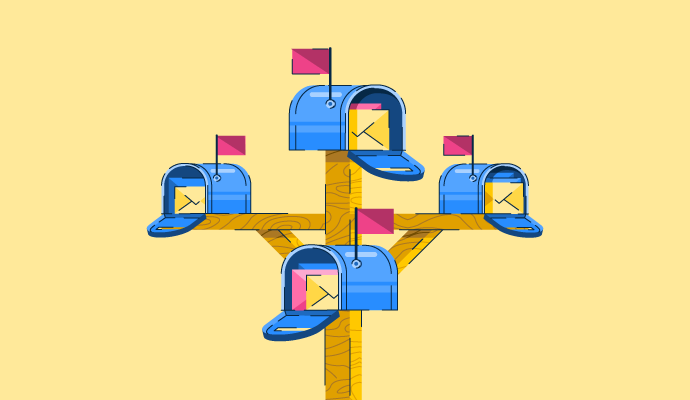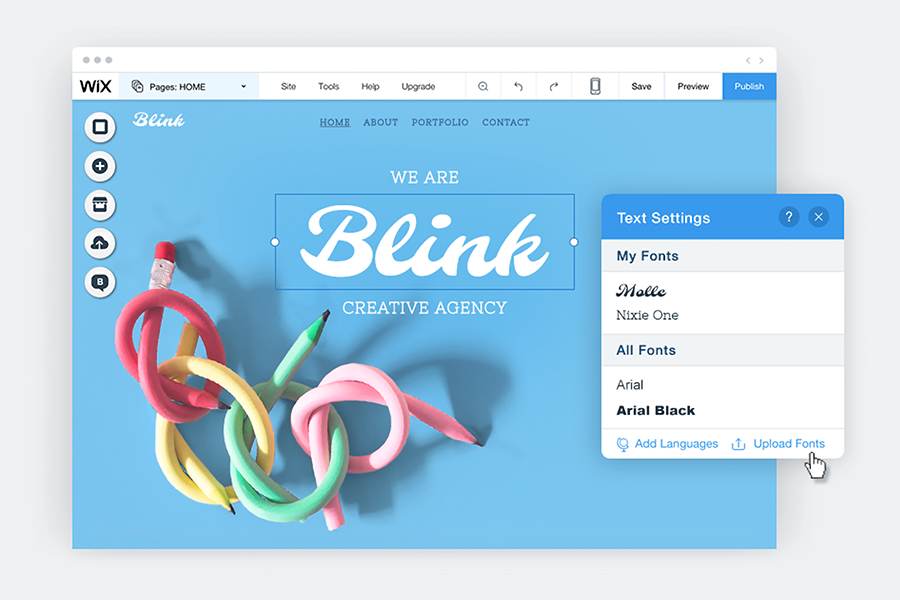
Forget what you’ve heard online—direct mail is far from obsolete.
In a world where B2C and B2B marketing largely unfolds in the digital realm, direct mail is a refreshingly effective strategy.
What is direct mail?
Direct mail is a marketing strategy that involves sending physical mail to a targeted audience. These mail pieces can be anything from brochures and catalogs to postcards and letters. The goal is to generate interest in a product or service and ultimately drive sales.
Armed with direct mail automation, you have the power to reach your entire database with just a click. In this piece, we’ll uncover the perks direct mail brings to both your marketing and sales game in this digital-first era.
Direct mail marketing examples
To better understand direct mail marketing, let’s examine some of its most common forms. You will recognize plenty of these in your own mailbox!
Coupons or postcards
Direct mail postcards and coupons are one of the most effective forms. When you send individuals a coupon, you give them a reason to check out your store, either in person or online. And if your discount is especially enticing, you’re appealing to shopaholics like myself!
Below is an example of a coupon recently received at my household. In addition to the discount coupon, the postcard has information on the store’s history, selling points (leashed pets are always a plus!), their social media handles, and a community initiative.
Notice that they also included a map. This makes it easy for people (like me!) who have trouble visualizing a store’s location from an address alone.
Coupons can directly impact your bottom line. They get people to buy your product, and that’s the whole goal!
Samples
When you have a high-quality product, the best way to showcase its value is to let consumers try it themselves. By sending free samples, you reduce the risk buyers feel when purchasing your product. No one wants to face buyer’s remorse when they realize they’ve wasted their money!
If someone is unsure about your product and wonders whether it lives up to the marketing claims on the packaging, give them a sample. This could push them over the edge to purchasing.
And, if your sample includes a limited-time coupon, you are even more likely to increase sales. For example, I am a huge fan of skincare, so I’m a regular customer of Dermstore.
Here you can see a sample they sent me:
Catalogs
Well, it’s not as common, but catalogs remain a form of direct mail solutions. As a kid, I absolutely loved the arrival of catalogs. (Oriental Trading and American Girl were wonderful ways to put off doing homework!) My household doesn’t receive many catalogs, but my parents do, and I still love looking through them.
Okay, I’ll admit it. You can buy anything and everything on the internet, but doesn’t that get overwhelming when looking for that perfect gift? And with all of those websites to search on, it’s reasonable to assume you won’t always appear at the top of those Google search results.
How can you ensure that customers go to you and not your competitors? The answer is – you guessed it! – catalogs.
This is the advantage of outbound marketing. You can’t always count on consumers to find you, and direct mail does the search work for them.
Customer appreciation gifts
The opportunity to send gifts doesn’t end when an individual becomes your customer.
In fact, considering the positive impact that customer lifetime value has on your bottom line, this might just be the most important time to start packing those parcels!
Sending your customers a gift, however big or small, is a great way to show your appreciation. It also goes a long way toward building and maintaining relationships.
Some companies send new clients a welcome gift as part of the onboarding process. It is a friendly way to welcome your new customers and start the relationship on the right foot. (And it makes your new client feel like they made the right decision when they signed that dotted line!)
Another time to send customer appreciation gifts is on a client’s yearly anniversary of working with your company. This shows that you still value your clients. It also provides another touch point with your clients, ensuring you stay at the top of their minds—and you do it in a very good way! And it never hurts to get those positive vibes out there before it’s time for contract renewals.
Remember that you don’t have to have a big marketing budget to show you care. The saying, “It’s the thought that counts,” is true.
Gift cards
Gift cards provide the value of gifts and promotional items without the cost. You’re sending your target market something they want (no one thinks a gift card is junk mail!) without the bulk mailing costs.
When you’re ready to purchase your gift cards, there are a few options. If you’re starting small, you can buy your gift cards at a store or online, as you would if buying just one.
If you’re buying your gift cards online, make sure you get that actual plastic gift card! It looks much more professional than a printed piece of paper. Without it, your recipient will miss out on that element of excitement. Gift card companies (yes, there are actual gift card companies!) enable you to buy and brand your gift cards.
It’s worth noting that these custom gift cards take more time to set up. However, they better serve your purpose. Once a prospect puts your gift card in their wallet, you want them to remember it was from you!
Why does direct mail marketing still work?
When you want your message to be seen, you have far less competition in an actual mailbox than an email inbox. And that is just one of the underlying principles that govern the effectiveness of direct mail marketing.
Another is called ‘reciprocity.’ It is one of Dr. Robert Cialdini’s six principles of persuasion in his best-selling book ‘Influence: The Psychology of Persuasion.’ Think of someone who’s nice to you. How do you act to them in return? I hope the answer is that you are nice too! You’ve dealt with the obligation of reciprocation yourself plenty of times. For example, have you ever found yourself in this situation?
Image source: Pinterest
Aside from social situations, reciprocation is also used in marketing. Reciprocity works so well it could almost be considered a marketer’s secret weapon. And, just like all those superhero movies, let’s hope marketers use the power of reciprocity for good.
Because, the truth is, reciprocity works on everyone — even doctors.
Whether your goal is to increase sales as a B2C marketer or help your sales representatives book meetings in B2B marketing, aim to send potential customers something of value. That value doesn’t have to be tangible. Throughout this page, you’ll see plenty of examples of gifts and promotional items used in direct mail. Even if your budget management rules don’t allow sending an expensive gift, you can use the principle of reciprocation to ensure your direct mail gets read and not trashed.
With great power comes great responsibility. Use this knowledge for good and not for evil. (I am not kidding; don’t go around giving all of us marketers a bad name!)
Direct mail marketing stands out amidst digital clutter. Here’s an overview of the benefits it can offer your business:
- High open rates: Direct mail boasts a significantly higher open rate than email marketing, making it more likely that recipients will see and engage with your message.
- High engagement: Direct mail provides a tangible experience that physically engages recipients. People are more likely to interact with and remember physical mail, increasing the chances of conversion and sales.
- Influence on purchasing decisions: Direct mail has a considerable influence on purchasing decisions, with a significant percentage of consumers making purchases in response to direct mail campaigns.
- Supports multiple marketing metrics: Direct mail not only drives sales but also supports various marketing key performance indicators (KPIs) such as website traffic. By integrating direct mail with online activities, businesses can effectively track and measure the success of their campaigns.
- Appeal to all generations: Unlike common misconceptions, direct mail is not limited to older demographics. Millennials, in particular, show a strong engagement with and interest in direct mail, making it a valuable channel for reaching diverse audiences.
Challenges of direct mail marketing
Direct mail marketing remains a powerful tool in a marketer’s arsenal, offering tangible benefits that digital channels often cannot replicate. However, alongside its advantages come a set of unique challenges:
- Time constraints: Direct mail campaigns often require more lead time due to printing, preparation, and postal service delivery schedules.
- Costs: Direct mail costs include expenses for printing, postage, mailing lists, and design. These services can be expensive for bulk production.
- Limited reach: Unlike digital marketing, direct mail campaigns may have a limited reach since they rely on physical delivery to specific addresses.
- Response rates: Response rates for direct mail campaigns can vary and may be lower than digital marketing channels. Unlike email marketing, follow-up is often frowned upon.
- Measurement and tracking: It can be challenging to accurately measure the effectiveness of direct mail campaigns and track return on investment (ROI) compared to digital marketing metrics.
- Environmental concerns: Some consumers may view direct mail services as wasteful or environmentally unfriendly, impacting brand perception.
- Postal service reliability: Reliance on postal services for delivery means that factors such as delays or errors in delivery can impact campaign effectiveness.
How to create a direct mail marketing campaign
Direct mail is pretty simple when you get down to it. It’s a process anyone can execute. Here are seven steps for you, as a marketer, to execute your direct mail marketing campaign:
Step 1: Identify your target market
There’s a good chance you already have a database with plenty of customer information. Now it’s time to put it to work! If you’re spending significant dollars on each recipient, you must do all you can to ensure those recipients are likely to buy your product.
Your target audience already includes specific demographics, such as age, gender, income, and location. Consider these demographics when executing your direct mail campaign and target recipients appropriately.
For example, the target market for the female fashion brand Forever 21 would be millennial females who care about fashion and want budget-friendly purchases. A retirement community would not be the ideal recipient for Forever 21’s direct mail!
Similarly, if you are sending a B2B direct mail campaign for a product that costs thousands (if not hundreds of thousands!) of dollars, you want to make sure your parcel reaches the company decision-makers.
Step 2: Purchase direct mail lists
You may be a B2B company with a list of prospects in your database. If you already know your direct mail recipients, check the accuracy of those addresses in your customer relationship management platform (CRM), then move on to step No. 3.
If not, and you need a list of recipients to send your direct mail, it’s time to purchase a direct mail list. Direct mail lists are lists of recipients that you purchase.
You can either rent or buy your direct mail list. When you buy a list, you can use it as many times as you want. The downside? You are also responsible for maintaining the list. Most companies choose to rent mailing lists; it is cheaper and less of a commitment. If you’re just dipping your toes into direct mail marketing, this is the route.
There are two types of direct mail lists you can purchase: compiled lists and response lists.
- Compiled lists are also known as “cold lists.” They consist of recipients from various sources, such as directories, phone books, warranties, surveys, magazine subscriptions, events, and even court records! Response rates for this list often tend to be lower, as the audience thinks of the emails as spam or junk.
- Response lists are made up of people who have opted in to receive direct mail and given permission for their details to be shared with businesses. Individuals on these lists have purchased or contacted companies similar to yours as a result of direct mail. Response rates tend to be higher, making this list more expensive.
Step 3: Design your direct mail package
Yes, direct mail is more likely to get opened and read than other forms of marketing. But prospects reading mail doesn’t do much to your ROI, does it? This is why you need a strong call-to-action (CTA). For example, if you send a coupon, add an expiration date.
Remember to proofread your direct mail copy! If you make a mistake on your website, it’s easy to update your text. Sadly, the same can’t be said for direct mail! The last thing you want is 1,000 postcards printed with a typo. Take the time to edit, and ask a coworker if they’re willing to give your copy a once-over, too. A second set of eyes never hurts in the publishing process!
If your direct mail campaign depends on a letter or postcard, your design is critical. You only have to engage the recipient before your mail is tossed aside, never to be seen again.
Depending on the size of your company, you may have a graphic design team or supplier you already work with. If not, the internet is full of design software providers with free templates, and you can always create your design in-house.
If you’re mailing a physical item, you must purchase your shipping materials. Boxes or bubble mailers, labels, and packing tape all add up. Consider custom boxes with your company colors or logo if you want to build excitement when your package arrives. This will help ensure the item is associated with your company. Also, consider adding a QR code to your mailers to increase web traffic from offline campaigns.
Put on some music or a podcast, and see if any co-workers are willing to help you out. Many hands make the work go faster, and you might be able to do some co-worker bonding!
Step 4: Set up processes for shipping
For small businesses, the United States Postal Service (USPS) is vital in direct mail marketing, offering a robust infrastructure and various services. It also allows you to use the free Every Door Direct Mail® (EDDM®) mail route mapping tool to target addresses in specific areas. Using it, you can market your business effectively with your community.
However, for large enterprises, manually sending out packages is not a feasible option. Direct mail automation software streamlines the shipping process for direct mail marketing campaigns in several ways:
You can import your entire audience list and segment them based on demographics, interests, or purchase history. This eliminates manual sorting and ensures the right mailers reach the right people.
Set up triggers to automate sending mailers based on specific customer actions. For example, a welcome postcard could be automatically sent to new customers, or a birthday discount mailer could be triggered based on a customer’s date of birth. This eliminates the need to manually schedule and send each mailer.
Step 5: Track and analyze results
Don’t just send out flyers and hope for the best. Here’s how to measure your campaign’s effectiveness:
Track the percentage of recipients who take action on your campaign. This is a key metric to gauge campaign interest and adjust future marketing efforts.
Pay attention to online mentions or social media notifications sparked by your mailer. Did people share pictures of your unique design? Did they comment on the offer? Social media buzz can be a great indicator of engagement and brand awareness generated by your direct mail campaign.
Look beyond just inquiries. Track conversions driven by the campaign and sales generated from the mailer to understand the ROI.
Analyze the data to see what worked and what didn’t. Did a specific offer resonate more? Did a particular design element attract attention? Use these insights to optimize future campaigns for better results.
Direct mail isn’t dead
Yes, we live in a digital age. Yes, email and social media are effective tools. But you can’t ignore the impact of direct mail.
Now that you know the benefits of direct mail marketing and how to execute a campaign, it’s time to start brainstorming! Like experiential marketing, direct mail is the perfect opportunity to get creative and have fun.
Remember to keep track of your process and where you see the best results. This will enable you to speed up the execution of your next direct mail advertising campaign.
Whenever you’re in doubt, ask yourself: Does this mail provide value to the recipient? You don’t just want your mail opened; you want it to serve your marketing goals.
Exploring other unique marketing strategies? Today’s brands use influencer marketing platforms to reach a ton of people with their content. Explore now!
This article was originally published in 2018. It has been updated with new information.
Kristen’s is a former senior content marketing specialist at G2. Her global marketing experience extends from Australia to Chicago, with expertise in B2B and B2C industries. Specializing in content, conversions, and events, Kristen spends her time outside of work time acting, learning nature photography, and joining in the #instadog fun with her Pug/Jack Russell, Bella. (she/her/hers)





